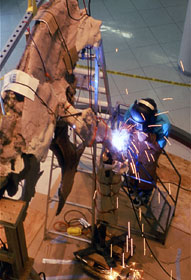 Building a free-standing mount of a forty-foot skeleton wasn't easy. The skeleton had to fit inside a circular stairwell twenty feet across and had to be braced with an internal steel armature to guard against the earthquakes that northern California has been known to experience. It also had to be as biologically accurate as possible; an active pose was desired.
A team of museum scientists, students and sculptors from Industrial Light and Magic fulfilled all of these conditions with flair.
Building a free-standing mount of a forty-foot skeleton wasn't easy. The skeleton had to fit inside a circular stairwell twenty feet across and had to be braced with an internal steel armature to guard against the earthquakes that northern California has been known to experience. It also had to be as biologically accurate as possible; an active pose was desired.
A team of museum scientists, students and sculptors from Industrial Light and Magic fulfilled all of these conditions with flair.
What follows is a short "virtual slide show" to demonstrate how it was accomplished — click on any of the slides below for a closer look.

The cast of the T. rex skeleton was shipped to us in a twelve-foot wooden crate. The 300-odd bones were unpacked and moved to the Prep Lab. Here you can get an idea of what the cast bones looked like "right out of the box."
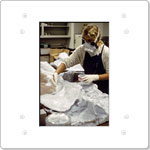
Each cast of each bone had to be washed, tooled, and painted by hand, a job for the entire crew. Here, UC undergraduate Tina Athena Trakadas applies an undercoat to the sacrum and ilia.
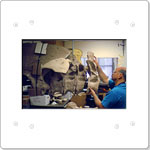
The skeleton's pose was worked out in the laboratory with a model before actual construction began. Each cast of the fossil was then cut and drilled to accommodate an internal framework of steel tubing. This was fabricated in the workshop and then assembled in place. In the Prep Lab, Bob Cooper of Industrial Light & Magic tests the dorsal vertebrae for fit.
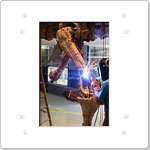
With the bones temporarily held in place with bungee cords, Mark Goodwin welds the steel frame.
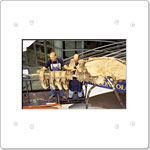
Bob Cooper and Mark Siegel, also of Industrial Light & Magic, prepare the dorsal vertebrae for final mounting on the frame.
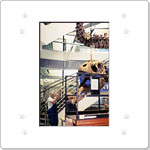
Bob Cooper and Mark Siegel lift the T. rex skull into position.

Mark Goodwin and Mark Songey (yes, there were three Marks working on this project!) in the process of attaching the ribs.
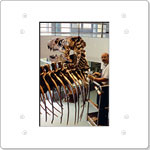
Bob Cooper does some final touching up with the paint.
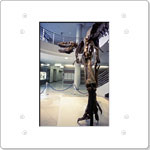
Finished! Tyrannosaurus rex keeps watch over the Wallace Atrium of the Valley Life Sciences Building.